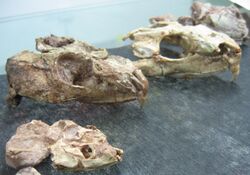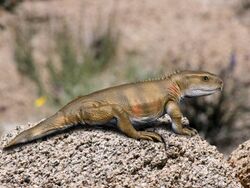Biology:Priosphenodon
| Priosphenodon | |
|---|---|

| |
| Reconstructed skeleton of P. avelesi, Carlos Ameghino Provincial Museum | |
| Scientific classification | |
| Kingdom: | |
| Phylum: | |
| Class: | |
| Subclass: | Diapsida
|
| Superorder: | |
| Order: | |
| Subfamily: | †Eilenodontinae
|
| Genus: | †Priosphenodon Apesteguia & Novas 2003[1]
|
| Species | |
| |
Priosphenodon is an extinct, large herbiviorous eilenodontine rhynchocephalian known from the mid-Cretaceous (Albian-Turonian) of Argentina .[1][2] It is one of the largest known sphenodontians.
Taxonomy
The type species of Priosphenodon, P. avelasi, was described in 2003 from the Late Cretaceous (Cenomanian-Turonian) aged Candeleros Formation of Argentina.[1] In 2014, a second smaller species, P. minimus was described from the same formation, though from an earlier unit suggested to be Early Cretaceous (Albian) in age.[2] Other authors have disputed the use of the genus Priosphenodon, with some authors treating P. avelasi and P. minimus as members of the previously named genus Kaikaifilusaurus instead.[3]
Description
left|thumb|Illustration of the skull in lateral viewAt slightly over 1 metre (3.3 ft) in total length, Priosphenodon avelasi is the largest known terrestrial sphenodontian.[1] The skull is around 15 centimetres (5.9 in) long.[2] The front of the upper jaw has a large beak-like structure probably formed from fused teeth on the premaxilla.[1] The teeth are densely packed with a cone-in-cone structure, and have prismatic enamel structure similar to those of mammals and the lizard Uromastyx, which was likely an adaptation to wear resistance in the absence of tooth replacement.[4] There is a large elongate tooth row on the palatine bones on the roof of the mouth that runs parallel to the maxillary tooth row.[1] The ungual phalanges are square in shape, and are expanded towards their distal ends, a condition unlike those known in other lepidosaurs, which typically have pointed ungual phalanges.[1]
P. minimus differs from P. avelasi by having a proportionally shorter skull in addition to a considerably smaller body size, among a variety of differences in the arrangement and shape of the skull bones.[2]
Ecology
During feeding the dentary teeth of Priosphenodon slotted between the maxillary and palatine tooth rows, which in turn with backward and forward (propalinal) motion of the jaw, served to shred plant material. The Candeleros Formation is suggested to have been deposited in an arid environment. Remains of P. avelasi are the most abundant of any terrestrial vertebrate at the sites it is found, and the lack of other herbivores found at the localities suggests that it may have been the only resident herbivore.[4]
References
- ↑ 1.0 1.1 1.2 1.3 1.4 1.5 1.6 1.7 Apesteguía, Sebastián; Novas, Fernando E. (9 October 2003). "Large Cretaceous sphenodontian from Patagonia provides insight into lepidosaur evolution in Gondwana". Nature 425 (6958): 609–612. doi:10.1038/nature01995. PMID 14534584. Bibcode: 2003Natur.425..609A.
- ↑ 2.0 2.1 2.2 2.3 Apesteguia, Sebastian; Carballido, Jose L. (March 2014). "A new eilenodontine (Lepidosauria, Sphenodontidae) from the Lower Cretaceous of central Patagonia". Journal of Vertebrate Paleontology 34 (2): 303–317. doi:10.1080/02724634.2013.803974.
- ↑ Agnolín, Federico L.; Aranciaga Rolando, A. Mauro; Chimento, Nicolás R.; Novas, Fernando E. (2023-10-12). "New small reptile remains from the Late Cretaceous of Patagonia increase morphological diversity of sphenodontids (Lepidosauria)" (in en). Proceedings of the Geologists' Association. doi:10.1016/j.pgeola.2023.09.007.
- ↑ 4.0 4.1 LeBlanc, Aaron R. H.; Apesteguía, Sebastián; Larsson, Hans C. E.; Caldwell, Michael W. (4 May 2020). "Unique Tooth Morphology and Prismatic Enamel in Late Cretaceous Sphenodontians from Argentina". Current Biology 30 (9): 1755–1761.e2. doi:10.1016/j.cub.2020.02.071. PMID 32220319.
Wikidata ☰ Q21368826 entry
 |



